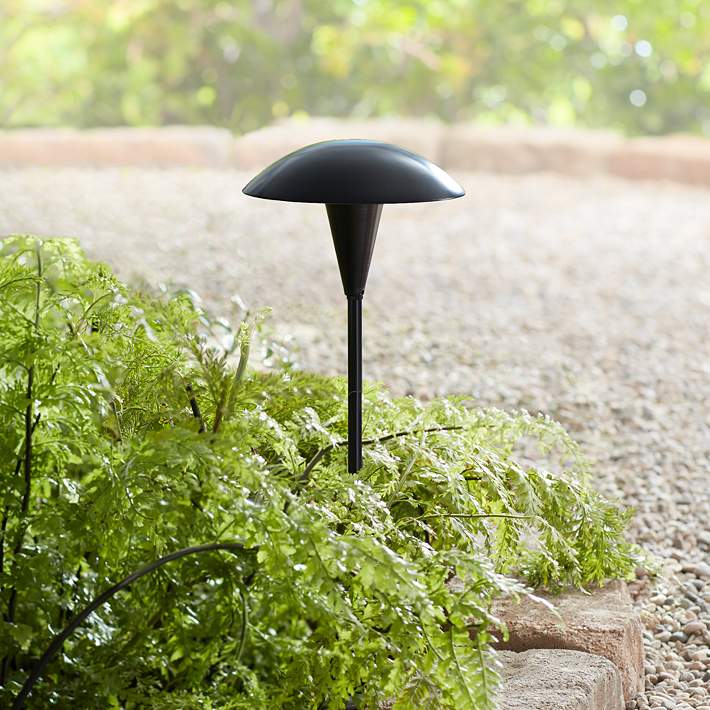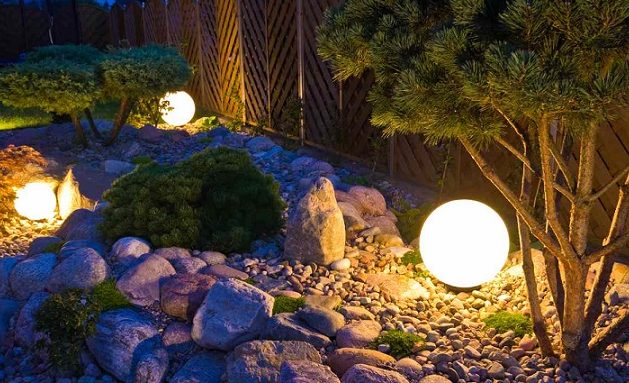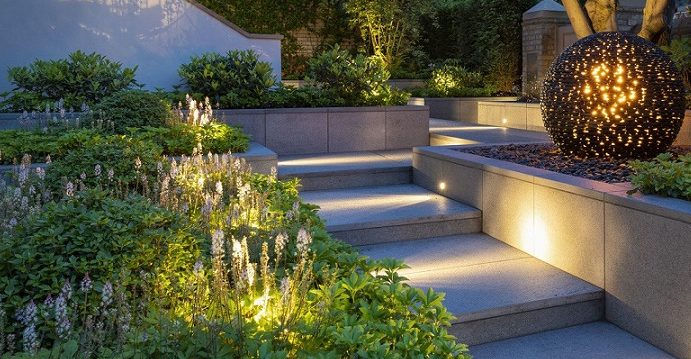Most gardens are defined by beds of flowers and herbaceous borders. Most plantings in these gardens, if not all, can be illuminated for late-evening viewing, reinforcing the shapes created during the day. Lighting plantings and flowers near a walkway or driveway not only illuminates the plantings but also provides sufficient illumination for safe passage on a walk, drive, or backyard patio. In addition, it helps prevent damage to herbaceous borders and flower beds.
Each situation is different and the types of plants you have will affect the way you light them but night lighting will paint a colorful tapestry.
Let’s look at some tips for plant and flower bed lighting.
Plant & Flower bed lighting
Perennials, annuals, and ground cover provide numerous lighting possibilities.
The best plants to illuminate are those with interesting foliage or flowering plants that hold their flowers well above their foliage. It is well to concentrate on plants with pronounced, attractive forms or blooms that are large enough or stand out high enough not to compete with foliage. For instance, tulips or geraniums in reasonably small clumps are nice because the blooms are clearly defined.
Each plant represents a part of the overall composition. One or more plants will represent feature elements, others as secondary or support elements while others might remain unlit.
All plants should be considered, whether intended to be lit or not. A plant may be located so that it will hide lighting fixtures.
Some people prefer to light only subjects classified as focal points. Fill-in lighting in shrub borders is often used to link illuminated focal points.For others, garden lighting is all about an illuminated horticultural panorama in which focal points are irrelevant.
Leaf & Flower color
Color is an important consideration when lighting borders. Darker-leaved specimens are less reflective than light-colored or variegated foliage.
Lighting camellias and rhododendrons, in flower, can be stunning, but for the rest of the year their dark, opaque leaves are fairly boring subjects for illumination. Pale lime-green or silvery foliage stands out well under relatively low levels of lighting while variegation adds contrast to individual plants.
Individual specimens may impart particularly colorful leaves, stems, flowers, or berries. Flowers in pale colors, such as pink, yellow, and white particularly stand out readily under relatively low levels of light.
Plant Texture & Shape
Texture is another often-forgotten characteristic. It may be the leaf and stem texture that is highlighted by lighting but more often it will be the overall impression of a group of plants. A screen of bamboo, for example, makes an interesting textural wall if grazed across the surface to bring out the pattern of its foliage.
Plants with strong leaf shapes offer opportunities for projecting shadows up through the plant or onto adjacent surfaces (shadowing).
Try grazing across the surface of low-growing plants with a spotlight placed at the end of the bed to bring out the texture. Some ground cover such as Japanese spurge, have interesting surface texture and can be illuminated using area lights or bullet lights grazing the plant surface.
If you have taller plants, try uplighting them from a path or from within the bed.
Lighting techniques
The are plenty of techniques that can bring out the beauty of plants, including moonlighting, spotlighting/accent lighting, silhouetting and shadowing.
- Moonlighting: Moonlighting aims to emulate the gentle glow of the moon, bating your entire bed in a soft glow. The lights are positioned above from a tall tree allowing the light to filter through the branches and leaves for a dappled effect on borders or beds below. Moonlighting is ideal for enhancing colors and creating visual interest.
- Floodlighting: Floodlighting reveals plantings in much the same way the sun or moonlighting does, from above to wash the bed with light. If you light a large bed or border, use floodlamps and aim them down on the flowers from high. But the effect may be pretty flat. When lighting flowers, the colors do not always come out well (this is especially true when one large light is used to illuminate a clump of flowers of different colors). You can introduce an additional layer of lighting through strategically placed mushroom lamps, extra overhead spotlights, lamp posts, or low-angle accent lights.
- Spotlighting: Spot or accent lighting is selective lighting and can dramatize a single plant or to draw attention to the most captivating blooms. When floodlighting a large flower bed with one or more overhead lights, it is advisable to incorporate accent lighting as well to highlight particular blooms and add visual interest.
- Silhouetting: This involves washing the wall or hedge behind a bed with a floodlamp (wash light), creating a dark outline of the plantings (silhouette). This only brings out shape and bulk without the texture, color, or detail of the blossoms. To bring out the colors, light must also be directed at them from the front.
- Shadowing: This involves placing a spotlight in front of a bed projecting shadows of plantings onto a wall behind it. For dramatic effect, light sword leaves perennials such as fortnight lilies by shadowing or silhouetting if a flowerbed has a wall behind it.
Look at the plants in your garden and decide which kind of lighting suits them best. The best flower bed lighting is done close up unless a bed is solidly planted. To highlight a clump, place a 2 to 5 watts downlighting fixture. The light is placed 12 to 24 inches above the flowers.
To accent a tight cluster of flowers, such as a clump of daffodils, conceal a small, upward-aimed bulb in the midst of them.
If your garden consists of beds of small shrubs or mixed plantings of annuals and herbaceous plants but without one dominant plant, a good solution is to dot small lights in and around to create pools of interest. With lower planting, downlighting may be the best using directional spotlights mounted on posts, a tree, or an adjacent wall.
The fixture placement will depend on the style of the garden. Take your cue from the design- a formal garden can have symmetrical lighting while an informal garden would be well served with random placement.
Ensure the result has some internal cohesion, not just the scattering of light. You want to provide illumination evenly across the entire bed, rather than focusing your lights on one end or another. It is important to light enough of the whole garden to give some impression of shape and space. Even so, being selective will pay off, light good specimens and aim for contrast.
You can also experiment with reflected light which is softer in quality. Try bouncing it off a light-colored wall or fence to diffuse the light.
In lighting plantings, as in other outdoor lighting, it pays to experiment before installing any permanent wiring or fixtures.
Regardless of the fixture choice, experimenting with colors is essential. While you might decide on white floodlights, don’t shy away from using colors to accentuate different aspects and areas of your garden. You can experiment with blue, yellow, or red LEDs. Choose colors that complement each flower in your bed.

Flower bed lighting ideas
Commonly employed fixtures for lighting flower beds include
- Mushroom pathway lights
- Fence lighting
- Concrete patio lighting
- Flower garden lights
- Globe lights
These fixtures emit a downward pool of light with minimal glare. Since these lights are near the flowers, it is advisable to use soft illumination to prevent harsh effects.
Flower Garden Lights
One effective way to illuminate flower beds is by using flower shield lights to focus on a specific edge. Individual fixtures can be employed to accentuate individual plants, shrubs, or trees. Stringing together several smaller units is especially useful for illuminating long, narrow flower beds or lower border plantings. These lights are typically mounted on spikes, and thus can easily be relocated to adjust the lighting according to the changing blooms.
Mushroom Pathway Lights
These are small, typically round lights placed on the ground amidst your flowers. They rise from the ground, resembling decorative mushrooms. They are about the same height as the flowers or slightly taller.
Aside from their attractiveness, they can also keep passersby from accidentally stepping off the path and onto your flowers.
Use this type of fixture to light the edge where the ground cover meets a lawn of paving.
Fence Lighting
This involves positioning lights atop each picket or lat of your garden fence to illuminate plants and flowers. This, in turn, casts light on the flowers and garden adornments at the base of each section of your fence.
You can alternate the lights on pickets or vary colors and brightness along alternate slats.
String lights

String lights are not limited to the holidays; they can enhance your flowerbed year-round. They are versatile and can be wrapped around various elements such as large plants, trees, and fences or draped around statues.
Opt for soft pinks, yellows, and bright whites
Globe Lights
Globe lights are spherical alternatives to traditional stake lighting. They provide visual interest and work especially well in gravel gardens or xeriscapes. Place lights along top-tier areas of your garden or behind and underneath plants for illumination.
To Sum Up
Design your herbaceous border and flower bed lighting with flexibility in mind. Flowers are transient, with their blooms changing over time and often evolving layouts. Plantings grow and their growth may change or hinder the lighting effects initially planned. Plan your lighting to be easily and quickly repositioned as needed.
Be aware that plants are sensitive to light for many functions of life. They require regular cycles of light and darkness to maintain growth, and strength and even to bloom.
Outdoor lights can affect plant growth, flowering, and dormancy in winter. Plants near bright artificial light sources may make more shoot and leaf growth as a result of extending the apparent length of the day. They may reach their mature size more quickly; they may also require pruning more often.
See you soon!


